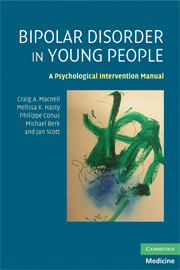Book contents
- Frontmatter
- Contents
- Preface
- Acknowledgements
- Introduction
- 1 Bipolar disorder
- 2 Assessment and engagement
- 3 Insight, adaptation, and functional recovery
- 4 Medication adherence
- 5 Cognitive behavioral therapy interventions
- 6 Social rhythm regulation
- 7 Relationship issues and family work
- 8 Alcohol, substance abuse, and other comorbid disorders
- 9 Identifying early warning signs, preventing relapse, and termination of therapy
- Appendices
- References
- Index
8 - Alcohol, substance abuse, and other comorbid disorders
Published online by Cambridge University Press: 06 July 2010
- Frontmatter
- Contents
- Preface
- Acknowledgements
- Introduction
- 1 Bipolar disorder
- 2 Assessment and engagement
- 3 Insight, adaptation, and functional recovery
- 4 Medication adherence
- 5 Cognitive behavioral therapy interventions
- 6 Social rhythm regulation
- 7 Relationship issues and family work
- 8 Alcohol, substance abuse, and other comorbid disorders
- 9 Identifying early warning signs, preventing relapse, and termination of therapy
- Appendices
- References
- Index
Summary
When sorrows come, they come not single spies, but in battalions.
Shakespeare, Hamlet (1999, p. 701)When working with many young people with bipolar disorder, managing comorbid disorders – particularly alcohol, substance use, and anxiety disorders – is an integral part of psychological treatment. This is because comorbidity can impact significantly on the effectiveness of other parts of the intervention, including engagement, work with families, psychoeducation, cognitive strategies, social rhythm, the development of sense of self, and relapse prevention. It is also important to note that it may be alcohol or substance use problems that first bring the young person to the attention of mental health services. Therefore, careful assessment can help identify whether the young person may be attempting to “self-medicate” mood difficulties, or whether increased substance or alcohol use is more related to impulsivity or disinhibition.
In clinical practice, work on comorbid difficulties is likely to be integrated throughout the intervention and may not constitute a separate module. The motivational interviewing approach described in this chapter can also be used to assess and enhance motivation to engage in treatment, and to assist with medication adherence. However, as with the preceding chapter on family and relationship work, interventions for comorbid disorders have been included as a separate chapter for ease of reading.
- Type
- Chapter
- Information
- Bipolar Disorder in Young PeopleA Psychological Intervention Manual, pp. 117 - 130Publisher: Cambridge University PressPrint publication year: 2009

